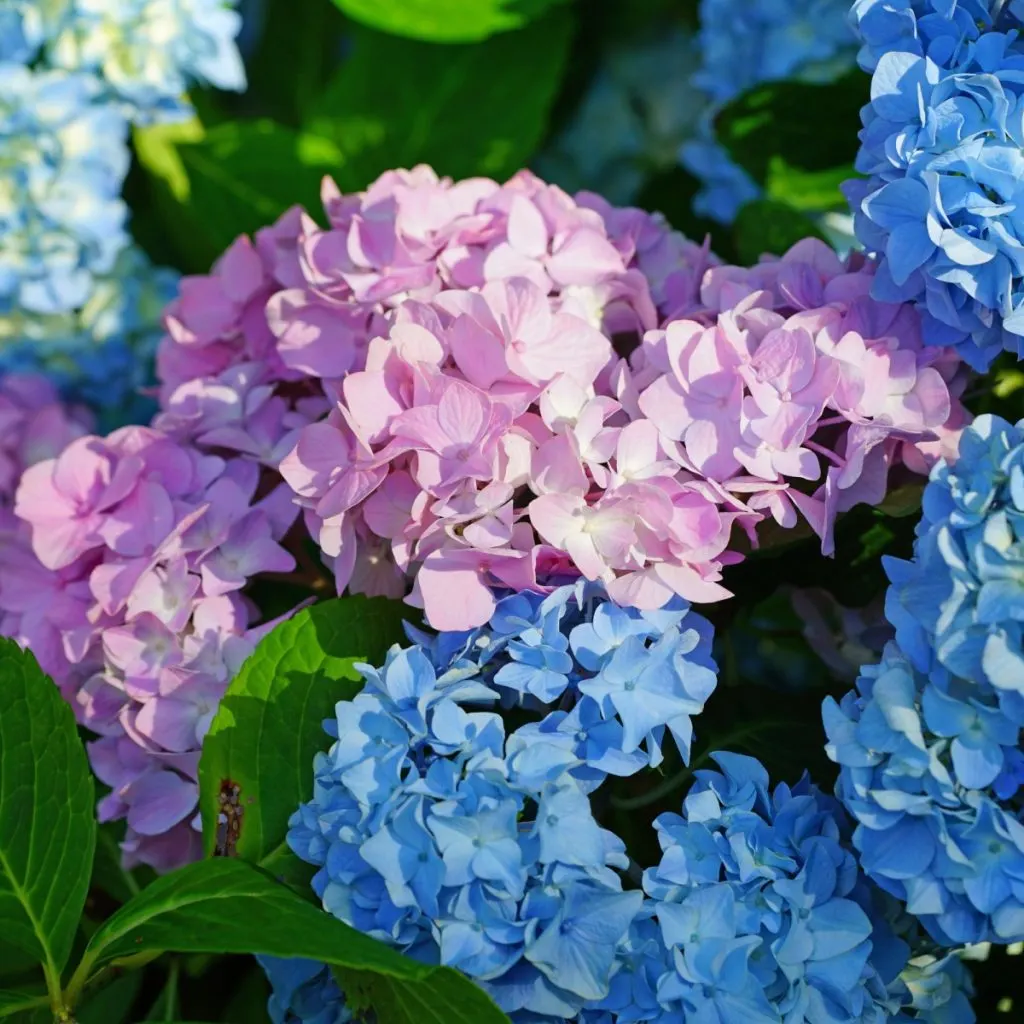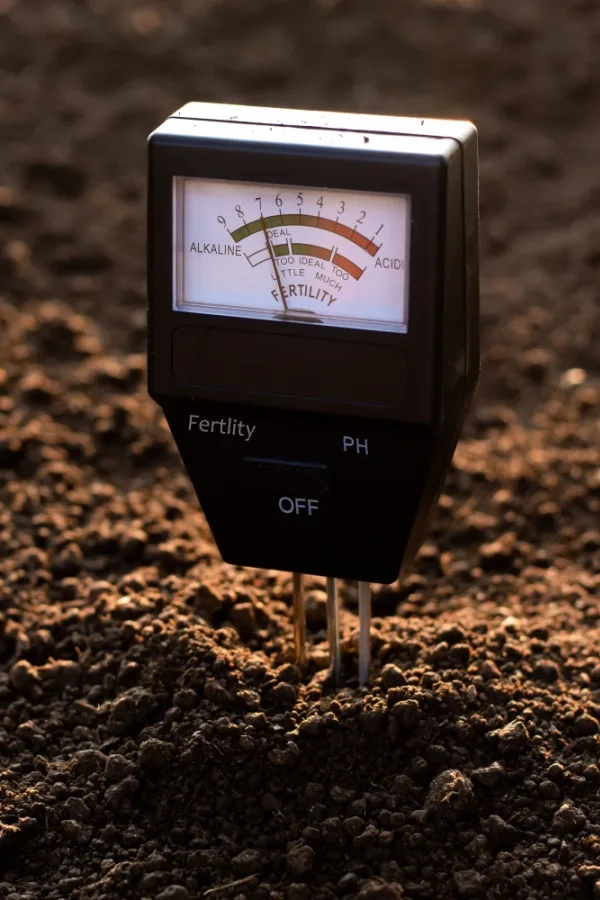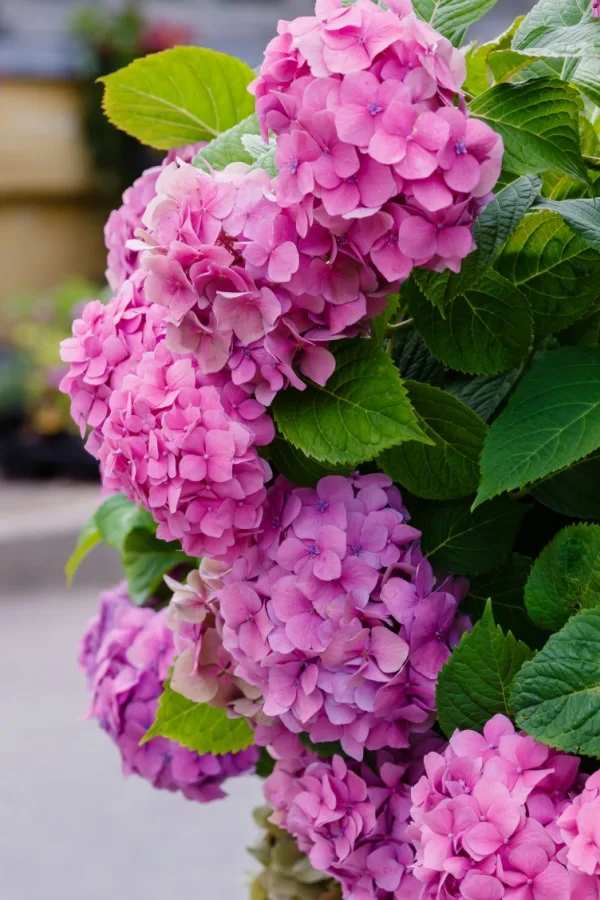Did you know that you can actually change the color of hydrangea blooms just by using different fertilizers and soil additives?
Hydrangeas are one of the most stunning flowering perennials available. With their lush green foliage and vibrant blooms that range in color from blue, pink, purple, green, and white, they are a common staple in many home gardens.
But what makes this plant even more special is that they are one of only a few flowers that are capable of changing bloom colors. That’s right, if you have blue or pink big leaf hydrangeas and you prefer the opposite color, you might be able to alter it – all by using fertilizer!

By simply adding specific fertilizers at the right time, you can tweak and alter vibrant blooms. It’s a practice that can take some time and modifications to get to work just right, but the rewards are more than worth it!
One note as you read, keep in mind that not all varieties of hydrangeas are capable of changing color. Mophead and Lacecap are two species that can, while white hydrangea blooms will stay white no matter what you do to the soil. But for those varieties that can, it can be fun to do!
How To Change The Color Of Hydrangeas
How Hydrangea Blooms Change Color
Many think that a hydrangea’s ability to change color is based on the pH level of the soil. In reality, it’s the amount of aluminum in the soil and how much the plant can absorb that really determines the bloom colors.
But pH does matter. Why? Because pH levels determine how much aluminum can be absorbed. So by using fertilizers to tweak the soil’s pH and how much aluminum the plant’s roots can take in, you can then alter the color of the blooms.
A higher pH refers to a soil that is alkaline (above 6.5). A soil with this type of pH blocks aluminum from being absorbed by the plant, causing blooms to be more pink.

On the other hand, lower pH levels (below 5.5) allow the aluminum to be easily absorbed, causing blooms to turn blue. These soils are more acidic in nature.
You’re probably wondering what about neutral soil pH levels that fall between these two extremes. Typically, your blooms will end up being purple, a color you can also achieve if you already have blue or pink blooms by altering the soil pH only slightly.
Test Your Soil
Before you attempt to alter the pH of your soil, it’s a good idea to get your soil tested. Having a baseline is key to properly altering the levels to achieve different bloom colors. It also takes some of the guesswork out of the equation.

The good news is this process doesn’t have to be complicated. All you need is a simple, inexpensive instant read soil pH meter. These will give you a good general idea of your soil’s pH to let you know what you can do. Product Link: Soil pH Meter
While changing the bloom color is possible, it can take time and patience to see the desired results. In fact, the process can take weeks or even months for the color of your hydrangea blooms to change.
Also, never alter the pH level of the soil for newly planted transplants. These hydrangeas are already trying to adjust to new growing conditions and throwing fertilizers at them too soon can cause issues for the overall health of the plant. Because of this, always allow plants to establish for one growing season before making new changes.
If You Want Pink Flowers – How To Change The Color Of Hydrangeas With Fertilizer!
In order to get pink blooms, you need to raise the pH level in the soil. This will help prevent the plants from absorbing aluminum, thus turning blooms pink.

The best way to do this is to use a fertilizer that is high in nitrogen and phosphorous. The higher nitrogen levels will help raise the pH of the soil. At the same time, the phosphorous prevents aluminum absorption while also helping to push out healthy blooms.
Another way to alter the pH is to apply garden lime. This granular fertilizer acts as a slow-release boost of nutrients that are easily absorbed into the plant’s roots every time it rains or you water plants. Product Link: Jobe’s Organics Soil Lime De-Acidifier
Apply the fertilizer or garden lime around April and again in October. This will help to slowly raise the soil’s pH level and turn your hydrangea blooms to pink.
Another option you can try is to add crushed eggshells around the base of each plant. The shells will help to slow the absorption of aluminum as well. Using eggshells can take a year or two to work, but they are a great free option!
If You Want Blue Flowers – Change The Color Of Hydrangeas
In order to turn pink or purple hydrangea blooms blue, the soil needs to be more acidic and less alkalinity. To achieve this, look for a fertilizer that has a low amount of phosphorus. Without the phosphorus in the way, the plants are better able to absorb the aluminum in the soil.

Another way to increase the acidity in the soil is to add sulfur. This natural element helps to promote vibrant blue color as well as fuller foliage as well. Product Link: Jobe’s Organics Granular Soil Amendment Soil Acidifier
In some cases, you can also increase the acidity levels by adding spent coffee grounds to the soil. Again, apply the fertilizer, sulfur, or coffee grounds around April and again in October. (For other uses for coffee grounds, check out “Saving Egg Shells & Coffee Grounds”.)
It can be a bit more difficult to go from pink flowers to blue flowers. However, it’s still possible. If you struggle to achieve blue tones, consider growing hydrangeas in containers where you have more control over the soil. For more hydrangea care tips, see our article: Spring Hydrangea Care – What You Need To Do Now For Big Blooms This Year!
Here’s to experimenting with the pH of your soil and seeing if you can change the colors of your hydrangea blooms!
Simple Garden Life
Follow Our Facebook Page For Even More Great Tips! Simple Garden Life Facebook Page
Simple Garden Life is a website dedicated to keeping gardening fun, simple and enjoyable! We publish two new articles each week along with a new garden podcast episode every two weeks. This article may contain affiliate links.
